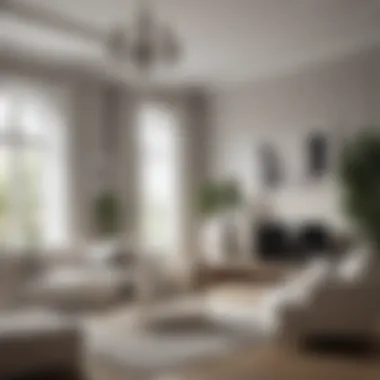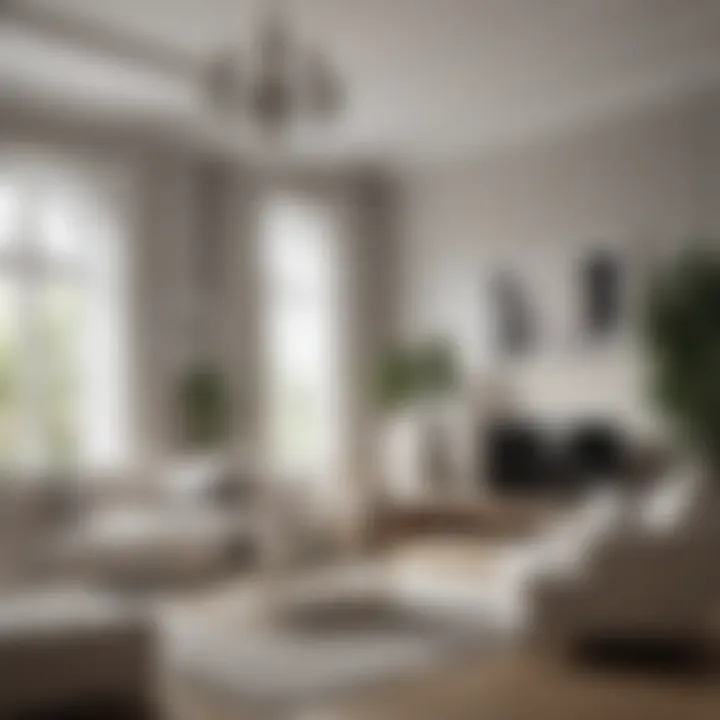Exploring Color Schemes for Living Rooms


Intro
Color in a living room serves more than just a decorative purpose. It establishes a mood, reflects personal style, and aids in creating a comfortable environment. Homeowners and design enthusiasts alike often overlook how pivotal color selection is in interior design. This article explores the intricacies of color schemes in living rooms, delving into their psychological, aesthetic, and functional implications. By understanding these factors, one can select palettes that elevate space beyond mere visuals, making it inviting and cohesive.
The choices made in color can influence perception and behavior in a room. For homeowners, it’s essential to recognize the influential role that colors have on comfort and ambiance. Interior design, with a well-thought-out color scheme, can transform the atmosphere, making it either lively or serene depending on preferences.
As we dive into this topic, we will categorize effective color palettes, consider environmental factors in selecting hues, and discuss techniques that elevate the living room’s design. The integration of color with furniture, art, and textiles will be crucial in this exploration, offering a comprehensive understanding of achieving harmonious living spaces.
Understanding the Importance of Color Schemes
Color schemes play a critical role in the design of living rooms. They influence not just the aesthetic appeal but also the psychological atmosphere of a space. Choosing the right colors can transform a dull room into a vibrant and inviting area. Conversely, the wrong choices may lead to discomfort or an unwelcoming environment.
Colors affect mood and emotions in subtle yet profound ways. For instance, cool colors like blue can evoke calmness, while warmer tones like red can generate energy. This psychological impact is essential to consider when designing a living area that caters to the needs and preferences of its occupants.
Moreover, the importance of color schemes extends beyond personal preference. In social settings, such as gatherings or parties, the ambiance created by color can influence interactions among guests. A well-chosen palette can encourage conversation and connection, making gatherings more enjoyable.
Critically, color schemes contribute to the perceived size and functionality of a living room. Light colors may make a small room feel larger and airier, while bold hues can create a cozy, intimate space. Therefore, understanding how colors interact with physical space is fundamental for effective interior design.
"Color is the keyboard, the eyes are the harmonies, the soul is the piano with many strings."
The Psychological Impact of Color
The psychological impact of color is a fascinating study. Different colors can trigger various emotional responses. For example, greens typically bring feelings of tranquility and freshness, reminding people of nature. Yellows, on the other hand, are known to inspire optimism and cheerfulness. Thus, selecting colors that resonate with desired emotional responses is crucial in design choices.
Interior designers often use this knowledge to evoke specific feelings within a space. For example, using calming colors in bedrooms promotes restful sleep, while bright and invigorating colors may be applied in playrooms or living areas for energy and fun.
Color Theory Basics
Understanding color theory is essential for creating effective color schemes. The color wheel is a foundational tool, consisting of primary, secondary, and tertiary colors. Primary colors are red, blue, and yellow; they cannot be created by mixing other colors. Secondary colors are produced by combining primary colors, such as green from blue and yellow.
Additionally, color harmony is a crucial concept. This refers to how colors work together. Complementary colors, which are opposite each other on the color wheel, create vibrant contrasts. Analogous colors, which are next to each other, produce a more serene and cohesive look. Mastery of these concepts enables designers to craft spaces that are both pleasing and effective.
In summary, understanding the psychological impact of color and the basics of color theory provides a strong foundation for choosing effective color schemes in living rooms.
Choosing the Right Color Palette
Choosing the right color palette is essential for creating a living room that reflects your style and meets your functional needs. The colors you select will affect the overall mood, energetic flow, and perception of space. A well-thought-out color scheme can enhance the aesthetic qualities of your room, making it inviting and comfortable.
When considering your color palette, think about how different colors interact. Each shade has its own personality and emotions associated with it. Therefore, understanding the various nuances in color is vital to achieving the desired outcome.
Warm Versus Cool Colors
Warm colors, such as red, orange, and yellow, tend to create a sense of energy and vibrancy. They can make a large space feel cozier. Warm colors are often seen as inviting and can stimulate conversation, making them great choices for living areas where social interaction occurs.
On the other hand, cool colors like blue, green, and purple typically evoke calmness and tranquility. They can make a small space appear more open and airy. Choosing cool colors can create a serene atmosphere, ideal for unwinding after a busy day. Balance is key; utilizing both warm and cool tones in a single palette can foster a dynamic environment while helping to define different areas within the space.
Monochromatic Schemes
Monochromatic color schemes use variations of a single color. This can involve different shades, tints, and tones of that color. Utilizing a monochromatic approach allows for a cohesive look, eliminating the risk of color clash. This style can make a living room appear sophisticated and unified.
However, to prevent monotony, you can introduce textures and patterns in fabrics and accessories. For example, a range of blue hues can be complemented by soft linens, robust couches, and delicate rugs, all sharing the same primary color.
Analogous Color Schemes
Analogous colors are those that are next to each other on the color wheel. They tend to harmonize well and create seamless transitions between hues. An example might be green, yellow-green, and yellow. This scheme is often pleasing to the eye, providing a sense of tranquility and comfort.
Using an analogous palette can limit the color selection, but it also simplifies decision-making. A well-executed analogous scheme will have sufficient variety to keep the space interesting without feeling chaotic or disorganized.
Complementary Colors and Their Uses
Complementary colors are found directly opposite each other on the color wheel. This striking contrast can make elements stand out and create visual interest in a living room. For instance, pairing blue and orange can draw attention to specific furniture pieces or artwork.


While complementary colors can provide a vibrant look, they should be used carefully to avoid overwhelming the senses. Including neutral colors between contrasting shades can balance the visual experience. Using accents, such as throw pillows or artwork, can introduce complementary colors without dominating the entire space.
Understanding these color-related terms allows homeowners and designers to craft thoughtful and appealing spaces that resonate with their intended ambiance.
When selecting a color palette, consider how each scheme aligns with your personal taste and lifestyle. An informed choice can help create a living room that feels both comfortable and visually captivating.
Popular Color Schemes for Living Rooms
Popular color schemes for living rooms play a crucial role in defining the overall ambiance and functionality of a space. It is not just about aesthetics, but also about creating an environment that resonates with the inhabitants' preferences and emotional needs. Selecting the right color palette can enhance a living room's appeal, influence mood, and even affect social dynamics during gatherings.
When choosing a color scheme, numerous factors come into play, such as lighting, furniture styles, and the intended use of the space. Effective color choices can make a room feel larger or cozier, brighten a dimly lit area, and more importantly, reflect the personality and lifestyle of those within it.
Neutrals: Timeless Elegance
Neutrals remain a favored choice for many homeowners. This palette includes shades like beige, gray, taupe, and cream. These colors can provide a calm and inviting backdrop that allows other elements in the room to shine.
The beauty of neutrals lies in their versatility. They can effortlessly complement any decorating style, from traditional to contemporary. Moreover, they work well with a variety of accent colors, making it easier to adapt the space for different moods and seasons.
"Neutrals offer a canvas that invites creativity without overwhelming the senses."
Another advantage is their longevity. Trends may come and go, but neutral palettes stand the test of time, providing a timeless elegance that remains stylish regardless of changing fashions.
Bold Contrasts: Making a Statement
Bold contrasts introduce a dramatic flair to a living room. High-contrast combinations, such as black and white or navy and mustard, can energize a space and create visual interest. This choice is often associated with modern design and can elevate the overall feel of the room.
Selecting bold colors should be done thoughtfully. It’s essential to consider the balance within the decor. If the walls are painted in a strong hue, softer tones should be applied in furniture or accessories to maintain equilibrium. A bold choice not only captures attention but also allows for personal expression, showcasing a taste for contemporary design.
Earthy Tones: Bringing the Outdoors In
Earthy tones encompass colors inspired by nature. Shades like terracotta, olive green, and deep browns offer warmth and tranquility. They can transport the essence of the outdoors into the living room, fostering a sense of connection to nature.
This palette is particularly beneficial for creating a cozy atmosphere. Earthy tones can ground a space, making it feel inviting and homey. They work well with natural materials like wood and stone, ensuring that the overall design is cohesive and harmonious. Additionally, these colors can be combined with vibrant accents to maintain a lively yet calming environment.
Pastels: Subtle and Soothing
Pastel colors, such as soft pinks, pale blues, and mint greens, bring a gentle and soothing quality to a living room. These shades create a serene environment conducive to relaxation, making them ideal for spaces meant for unwinding after a long day.
Pastels can also enhance natural light, generating a feeling of openness and airiness. When combined with modern furnishings, they evoke a fresh and contemporary look. The soft tones act as a perfect background for artwork and decorative pieces, allowing these items to draw attention without competing with the overall tranquility of the space.
Incorporating Color with Furniture and Decor
Color is not just about paint on the walls. It extends into all aspects of interior design, specifically furniture and decor. Integrating color in these elements can significantly impact the overall ambience of a living room. Color is an essential part of visual coherence and can define spaces more than mere furniture arrangement can.
Selecting the right hues for furniture and decor enhances the mood of a room. It invites guests in and makes them feel welcome. In this section, we explore the specific elements that play a role in achieving the desired effect through careful color incorporation. Understanding these benefits can help homeowners and design enthusiasts make informed choices about their living space.
The Role of Upholstery and Fabrics
Upholstery plays a crucial role in color schemes. Sofas, chairs, and cushions can be focal points, and the choice of fabric and color is essential. For instance, a deep navy blue fabric can create a striking contrast against neutral walls. Conversely, soft pastels can invoke tranquility in the environment.
Additionally, patterns in upholstery can offer unique opportunities for incorporating color. Here are some considerations:
- Durability and Maintenance: Some colors may show stains more than others. Light colors can accentuate dirt while dark fabrics may hide wear and tear.
- Coordination: Ensure that the color of upholstery harmonizes with other elements like curtains and rugs. This creates visual balance.
- Texture: Fabrics such as velvet or linen carry colors differently. Choosing the right texture can enhance or diminish color impact.
Artwork as a Color Focal Point
Art can serve as a color focal point in any living room. A well-placed painting or sculpture can introduce bold colors and establish a theme. Choosing artwork that complements the existing color palette can create a stunning visual effect.
When selecting artwork, consider the following:
- Theme Harmony: The artwork should align with the overall design theme. Modern art might not fit well in a rustic setting.
- Color Integration: Use colors from the artwork to inform other decor choices, ensuring all elements coalesce. For example, a painting with deep reds could influence the selection of cushions or curtains.
- Scale and Placement: Larger pieces can dominate a wall while smaller pieces might look better in clusters. The placement should be intentional to maximize color impact.


Accessorizing with Color
Accessories are the finishing touches that can make or break a color scheme. Items such as pillows, throws, vases, and decorative objects can introduce color without committing to large pieces.
Here are ways to successfully accessorize with color:
- Layering Colors: Introduce varying shades of a single color to create depth. A mix of light and dark blues in accessories can be visually appealing.
- Mixing Textures: Incorporating different materials—ceramic, glass, wood—adds interest and allows colors to interact differently.
- Seasonal Changes: Accessories are easy to change with the seasons or occasions, allowing for vibrant displays without the need for extensive redecorating.
"Color is the keyboard, the eyes are the harmonies, the soul is the piano with many strings."
— Wassily Kandinsky
The Role of Light in Color Perception
Understanding the role of light in color perception is vital for creating an alluring living room ambiance. Light influences how colors are perceived and can completely alter the room's mood. By recognizing the impact of light on your chosen color scheme, you can enhance your living space effectively. Factors such as natural and artificial lighting affect how colors appear in different contexts. Attention to these details can lead homeowners and design enthusiasts to more satisfying design choices.
Natural Light Considerations
Natural light is often considered the most favorable light source. It varies throughout the day and can greatly shift the atmosphere in a living room. In the morning, sunlight tends to be softer and has a cooler hue. This can enhance cool color schemes, giving off a fresh feel. As the day progresses, the sunlight becomes warmer and more golden, making warmer colors appear more vibrant.
When considering how natural light enters your space, observe the direction and intensity of sunlight. South-facing rooms generally receive the most light, making vibrant colors more effective. Conversely, north-facing rooms produce cooler light, which may require warmer colors for balance.
Tips for maximizing natural light:
- Use large windows: They allow for more light to enter the room, enhancing the colors.
- Choose light, reflective surfaces: Mirrors and light-colored fabrics can help distribute light effectively throughout the space.
- Consider window treatments: Sheer curtains or blinds can allow for brightness without sacrificing privacy.
Artificial Lighting and Its Effects
Artificial lighting plays an equally important role in color perception, especially during evening hours. Different light sources, such as LEDs, fluorescents, and incandescent bulbs, emit varying color temperatures, impacting how colors look on walls and furnishings. For instance, incandescent bulbs provide a warm, soft light, complementing warm colors beautifully. In contrast, fluorescent lights can produce a harsher feel that might dull colors.
Understanding the color temperature, usually measured in Kelvin, can guide homeowners in making effective lighting choices. Warmer lights (around 2700K-3000K) create a cozy atmosphere and enhance yellows and reds. Cooler lights (5000K-6500K) are more refreshing and can be beneficial for highlighting blues and greens.
Key Considerations for Artificial Lighting:
Key Considerations for Artificial Lighting:
- Layer your lighting: Combine ambient, task, and accent lighting to create depth.
- Test before settling: Always check colors with different artificial lights before making a final decision on paint and furniture.
- Consider dimmers: Adjustable lighting allows for flexibility, catering to various moods and times of day.
Adapting Color Schemes to Different Spaces
Adapting color schemes to various living room layouts is crucial for creating a harmonious and functional environment. Different areas in a home often serve distinct purposes, and the choice of colors can significantly affect how these spaces are perceived and experienced. Factors such as lighting, size, and intended use of the space must be carefully considered when selecting a color scheme. This tailored approach ensures that each area not only looks aesthetically pleasing but also feels inviting and practical.
Open Concept Living Areas
In open concept living areas, color schemes play a pivotal role in defining different zones without physical barriers. The absence of walls presents a unique challenge, as one color choice can influence the entire space's atmosphere. It is essential to select colors that complement each other while respecting the flow of the area. Using cohesive color palettes can help achieve this balance. For example, light grays combined with accent hues of navy can create a sophisticated yet casual vibe. Consider emphasizing various functional zones—such as the living, dining, and kitchen areas—by using slightly varied shades within a unified palette.
Here are some tips for achieving a successful color scheme in open concept areas:
- Use transitional colors: Colors like beige or soft greens can link different spaces while providing visual interest.
- Incorporate accents: Decorative elements in darker or bolder colors can define specific spots, adding a focal point.
- Consider the view: When looking out to adjoining spaces, ensure colors engage well with what sits beyond, especially if large windows dominate the area.
Cozy Nooks and Corner Spaces
Cozy nooks and corner spaces demand a different approach. These intimate areas can evoke comfort and relaxation, making the color scheme even more pivotal. Opting for warm color tones can enhance the inviting nature of these spots. For instance, soft yellows or warm taupes can foster a sense of calm and intimacy. Bright colors, while enticing, may overwhelm such spaces, so it is better to choose gentle shades that make them feel welcoming.
Consider these points when selecting a color scheme for cozy nooks:
- Create contrast: Use a lighter shade on walls to offset darker furniture, making the area feel expansive while providing balance.
- Layer with textiles: Incorporate cushions, throws, and rugs that use varying textures and colors to enhance the visual palette.
- Balance natural light: Assess how sunlight enters during different times of the day. Choosing colors that harmonize with daylight can enhance the feeling of warmth and comfort.
"Color is a powerful tool in design, guiding emotions and perceptions in our most personal spaces."
This careful consideration of color schemes in both open concept living areas and cozy nooks ensures that each space serves its intended purpose while remaining aesthetically cohesive.
Common Mistakes in Color Scheme Selection


Understanding common mistakes in color scheme selection is crucial for anyone who aims to create a well-designed living room. Selecting the right color palette can decisively impact the mood and functionality of a space. However, it is all too common for individuals to misstep, leading to unsatisfactory results. Being aware of these errors can help homeowners and design enthusiasts make better choices. This section will explore two key mistakes: the overuse of bold colors and ignoring flow and harmony between colors.
Overuse of Bold Colors
Bold colors can have a profound impact on a living room. They can create excitement and draw attention. However, an overzealous application of vibrant hues can overwhelm the senses. When bold colors dominate, they can overshadow other design elements. This happens often when homeowners paint all walls in bright colors or use excessively loud furniture.
The mistake here is not balanced with softer tones. If a room is filled with strong colors, the visual noise can lead to discomfort. Instead, using bold colors as accents works better. For example, a red sofa or a bright blue chair can pop against neutral walls. This creates interest without bombarding the observer.
When planning a bold color scheme, consider the total area that will be colored. A good practice is to follow the 60-30-10 rule. This means:
- 60% should be a dominant neutral color
- 30% is for a secondary color, which may be bold but not overpowering
- 10% should consist of an accent color to finish the look
This approach helps to maintain an inviting environment while allowing for creativity and personal expression.
Ignoring Flow and Harmony
Another common pitfall in color scheme selection is ignoring flow and harmony within the space. A living room is often part of a larger area, possibly connected to a dining room or an open kitchen. Therefore, color continuity is essential to create a cohesive look. Ignoring this can result in a disjointed appearance that detracts from the aesthetics of the entire space.
To achieve color harmony, it's important to consider how colors interact with each other. Using complementary colors or sticking to a single color family can create a smoother transition. When shades clash, it can create discomfort and confusion in the viewer’s eye. Ensuring that colors relate within the context of the house is vital. This can include ensuring that adjacent spaces share similar tones or hues.
People often think of flow in visual terms only. However, the emotional flow of colors is important, too. Colors create emotions and feelings. A space swathed in blues and greens may feel calm and serene, whereas reds and yellows can invoke warmth and energy. It is beneficial to choose colors that not only look good together but also complement the desired mood of each area.
"Creating a harmonious flow in color selection allows each space to sing together rather than shout at one another."
Creating Visual Balance with Color
Creating visual balance with color is essential in living room design. It involves arranging colors in a manner that feels stable and harmonious. This concept greatly influences the perception of space and can affect the overall mood of the room. The right balance can make a room feel inviting and comfortable, while poor balance can lead to discomfort or disarray.
Using Color to Define Spaces
Colors have a unique ability to define different areas within a single space. For instance, using lighter colors in a small nook can make it feel more open, while darker shades can create an intimate feel. Notably, open concept areas benefit from defined color zones. By choosing distinct yet complementary colors for different areas, one can create a sense of flow and organization.
Here are some strategies to consider:
- Zone with Color: Use separate palettes for the dining and living areas to delineate them within an open space.
- Area Rugs: Utilize rugs in different hues that ground each area visually without harsh lines.
- Accent Walls: Paint one wall in a darker color to add depth and separate a conversation area without the need for physical barriers.
"Color is a powerful form of nonverbal communication."
Maintaining a Cohesive Design
Maintaining a cohesive design is crucial for an aesthetically pleasing living room. This refers to how colors interact across various elements in the space, ensuring the overall look is unified. When different colors clash, the living room may feel chaotic. To avoid this, one must think of color coordination among furniture, walls, and accessories.
In achieving cohesion, the following tips are useful:
- Use a Color Wheel: Refer to a color wheel to find hues that complement each other. This creates a natural flow.
- Limit Color Palette: Stick to two to three dominant colors. This helps achieve a restricted yet versatile aesthetic.
- Repeat Colors: Utilize repeated elements, such as throw pillows or art pieces that echo similar colors found in other areas. This creates continuity.
In summary, creating visual balance with color involves thoughtful execution and consideration of spatial definitions. It is not merely about selecting colors but about how they interact and coexist. A careful blend can produce a serene living room that embodies comfort and style.
Culmination: The Art of Color Schemes in Living Rooms
The significance of color schemes in living rooms cannot be overstated. They have the power to influence mood, create ambiance, and shape the overall perception of a space. By understanding the psychological impact of colors, homeowners can effectively transform their living rooms into inviting environments. Everyday life occurs in these spaces, and the choice of color can enhance or diminish comfort and relaxation.
In this article, we explored several essential elements related to color schemes. First, we discussed the foundational principles of color theory and its implications in design choices. Next, we examined how to select the right color palette, emphasizing the distinctions between warm and cool colors, as well as the interplay between contrasting hues. Popular color schemes, including neutrals, bold contrasts, earthy tones, and pastels, were analyzed in detail to illustrate their versatility and appeal.
Furthermore, we highlighted the integration of color through furniture and decor. Understanding how upholstery, artwork, and accessories contribute to the overall aesthetic is crucial for any design enthusiast. The influence of lighting on color perception was also addressed, as it plays a vital role in how colors are viewed in different environments. This highlights the need for a comprehensive approach to selecting color schemes.
Recap of Key Points
- Psychological impact: Colors affect emotions and can create different atmospheres.
- Color theory: Knowing the basics helps in making informed choices.
- Selecting palettes: Assess the contrasts, monochromatic ideas, and analogous schemes for variety.
- Popular schemes: Neutral, bold, earthy, and pastel color palettes each offer unique benefits.
- Lighting considerations: Both natural and artificial light influence color effectiveness.
- Furnishings and decor: Color use extends beyond walls to include all elements of the room.
Encouragement for Exploration
As you contemplate your living room's color scheme, consider the vast array of choices available. Experimenting with different colors can lead to unexpected yet delightful results. Engage in the process of swatching and testing colors against various lighting conditions. This exploration can lead to deeper appreciation of how color interacts within the environment.
Do not shy away from bold choices; sometimes the best discoveries emerge from the audacious application of color. Dare to challenge the conventional norms by mixing unexpected colors or using modern patterns. The learning experience may be insightful, enhancing both your knowledge and your living space.
Ultimately, the art of color schemes is about personal expression and creating a sanctuary that reflects your style. So, take the time to explore, observe, and make informed decisions. Your living room is more than just a place; it conditions mood, fosters social connections, and serves as a refuge at the end of the day.



